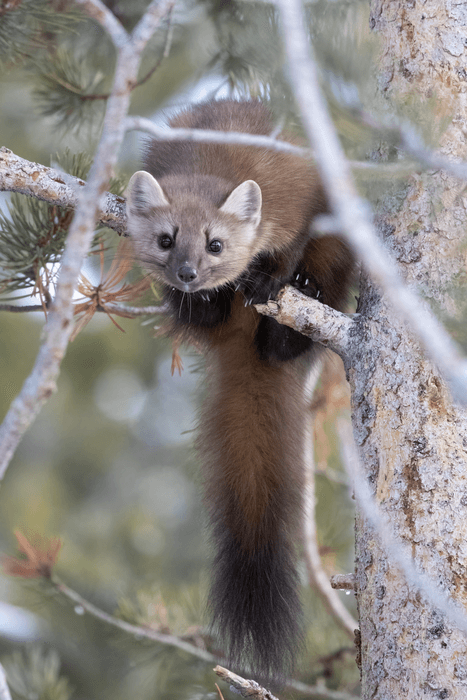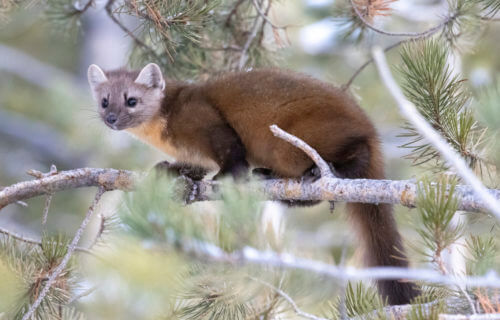RALEIGH, N.C. — Humans are changing the diets of the wild American marten, who are carnivores, making them more likely to consume plant-based meals.
Researchers from North Carolina State University say the carnivorous mammals eat more fruit and vegetables when they live in areas closer to humans. The findings provide new insight into the health of wild ecosystems and could boost conservation efforts.
“Specifically, we found that wild marten in relatively undisturbed environments have more carnivorous diets than martens in human-affected areas,” says co-lead author Erin McKenney, an assistant professor of applied ecology at NC State, in a university release.
About the size of a cat, martens are related to weasels, ferrets, and mink. The opportunistic feeder will eat anything from insects and rodents to small mammals. They usually kill their prey with a quick, powerful bite to the back of the animal’s neck.
Published in the journal PLoS ONE, the team found gut microbiomes of marten in the pristine forest of the Huron Mountain Club in Michigan were clearly distinct from those harvested elsewhere.
“This reflects the fact that marten in relatively pristine forest are able to forage at a higher trophic level, meaning they occupy a higher place in the food web,” explains co-lead author Dr. Diana Lafferty of Northern Michigan University.
“In other words, the marten in relatively pristine forest have a more carnivorous diet, whereas marten in areas where there are more people were more omnivorous. Basically, the findings tell us a disturbed landscape results in a significantly different diet, which is reflected in their gut microbiomes.”

Humans may be the biggest threat to martens in the wild
Study authors collected gut microbiome data from 16 martens caught during the trapping season and another five captured safely and released in the Huron Mountain Club.
“In conjunction with our other work on carnivore microbiomes, this finding tells us the microbial ecosystems in carnivore guts can vary significantly, reflecting a carnivore’s environment,” McKenney says. “Among other things, this means we can tell how much humans are impacting an area by assessing the gut microbiomes of carnivores that live in that area – which can be done by testing wild animal feces. In practical terms, this work is revealing a valuable tool for assessing the health of wild ecosystems.”
The animals tend to hunt at dusk and dawn, when critters can be found alone. They dwell mostly in trees.
“Our goal here was to determine how, if at all, human disturbance of a landscape affects the gut microbiome of American marten that live in that landscape,” Lafferty adds.
Martens mark their trails with strong scent glands. They will often chase squirrels through wooded areas.
“The Huron Mountain Club is particularly important for this study, because it’s relatively pristine – one of the largest, primeval forests in the eastern United States,” Lafferty continues. “That makes it an excellent juxtaposition to the 16 marten that were harvested, since those were collected in regions that are more impacted by human activity.”
The solitary animals can also swim and dive well. Although humans do hunt martens for their fur, there are few predators in the wild which hunt them.
“It’s also worth noting that we were able to trap and release the marten in Huron Mountain Club during the dead of winter because we designed and built custom box traps to protect them from the elements,” says co-author Chris Kailing, who worked on the project while at Northern Michigan University. “That’s of interest because it makes winter sampling possible for future wildlife research even in harsh winter conditions.”
Marten are extremely agile climbers, helped by a long bushy tail for balance during treetop adventures.
“This is the latest chapter in an ongoing body of research that is helping us understand carnivore gut microbiomes,” McKenney concludes.
“Carnivore gut microbiomes are inherently more variable than the gut microbiomes of other animals. This study lends nuance to the emerging picture that all of this variability is not just noise. Rather, this variability stems from the nutritional landscape carnivores have access to – and that, in turn, reflects the health of the ecosystem carnivores inhabit. And that means that monitoring the gut microbiome of wild carnivores can offer us real insight into the ecosystems those carnivores live in.”
South West News Service writer Mark Waghorn contributed to this report.

